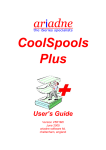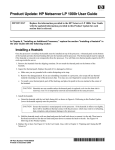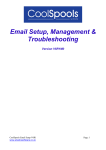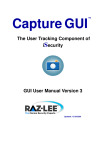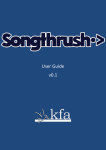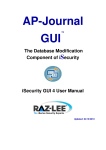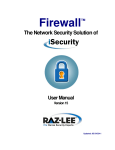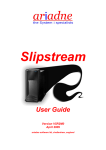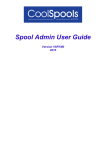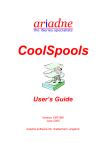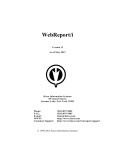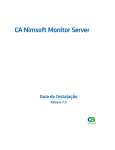Download User's Guide - Ariadne Software
Transcript
NetServer ToolKit User’s Guide Version V1R1M0 January 2007 ariadne software ltd. cheltenham, england Table of Contents Introduction ................................................................................................................ 3 Warranty ................................................................................................................. 3 Minimum OS/400 Release Level ............................................................................ 3 Licensed Program Id and Product Library .............................................................. 4 Installation .................................................................................................................. 5 Method 1: Installing NetServer ToolKit using FTP .................................................. 5 Method 2: Installing NetServer ToolKit using the IFS ............................................. 7 Maintenance............................................................................................................... 9 Method 1: Installing a PTF using FTP................................................................... 10 Method 2: Installing a PTF using the IFS.............................................................. 11 Getting Started with NetServer ToolKit..................................................................... 14 Introduction NetServer ToolKit is a completely free software package for the IBM System I (AS/400, iSeries) which provides a quick and convenient way of configuring and managing NetServer file shares. A NetServer file share is an area of the System i’s file storage that can be made available to clients on the network in the same way that you can share files on a Windows server. For example, if your System i is known to the network as LONDON and you create a NetServer file share called HOME to share the directory /home, PCs can access files saved in that directory either by: a) using path names of the form \\LONDON\HOME\... or b) mapping a network drive (e.g. i:) to \\LONDON\HOME and then accessing the files under i:\ For further details, see: http://publib.boulder.ibm.com/infocenter/iseries/V1r3/index.jsp?topic=/rzahl/rzahlnetfil eshare.htm NetServer file shares provide a simple but secure and effective way of giving PC users access to files saved on your System I IFS, for example spooled files converted to PDFs using ariadne’s CoolSpools product or database files converted to Excel spreadsheets using ariadne’s Slipstream. You can create the files on the System I (for example, in your overnight batch processes), then your users and customers can access those files from their PCs during the day (for example, in Acrobat Reader or Excel) using the NetServer file share. The problem with NetServer file shares is that the only means IBM provides of managing them is Operations Navigator, which is heavy on PC resources. Many people find OpsNav slow and cumbersome to use and would prefer a simple, traditional AS/400 green screen alternative. That is what NetServer ToolKit provides. We will be developing NetServer ToolKit further in the future and intend to add new functionality at regular intervals. Warranty ariadne software ltd. makes no warranty, either expressed or implied, with respect to the software product, its merchantability or its fitness for any particular purpose. The software product and documentation are provided on an "AS IS" basis. ariadne software ltd. assumes no responsibility for the use of the software product. Minimum OS/400 Release Level The minimum OS/400 release level required to run NetServer ToolKit V1 is OS/400 V5R1M0. If you are running V4R5M0 or an earlier version of OS400, you will not be able to install NetServer ToolKit. Page: 3 Licensed Program Id and Product Library The licensed program identifier for NetServer ToolKit V1R1 is 1NSTLKT and the version code is V1R1M0. The product library for NetServer ToolKit V1 is NSTLKTV1R1. Page: 4 Installation If you downloaded NetServer ToolKit from the Internet, or received the product via e-mail, you will have received a zip file called NSTLKTV1R1.ZIP. This zip files contain everything you need to get started with NetServer ToolKit. This section describes two possible procedures for installing NetServer ToolKit on your iSeries. Please select one of the two methods described below and follow the steps carefully and in the order indicated. Method 1 is the simplest, but requires the use of FTP to your iSeries. If FTP is unavailable to you, for whatever reason, you may use Method 2 instead. Steps to be carried out on the PC are shown in green, steps to be carried out on the iSeries in blue. Method 1: Installing NetServer ToolKit using FTP This method uses FTP (File Transfer Protocol) to transfer the NetServer ToolKit product files from your PC to your iSeries. It is assumed that you have stored the NSTLKTV1R1.ZIP file which you downloaded from the Internet or received via e-mail on your PC and that you have enabled an FTP link between your PC and your iSeries. Step 1 On your PC, create an install directory for NetServer ToolKit, either within Windows Explorer, or from the DOS prompt, e.g.: md c:\nstoolkit Save or copy the zip file that you downloaded or received into this directory. Step 2 On your PC, unzip the contents of the zip file into the directory you just created using pkunzip, WinZip, Norton UnZip etc. Step 3 On your iSeries, decide which library you wish to use for the install procedure and create a save file in that library, e.g. crtsavf lib_name/nstoolkit where lib_name is the name of the library you chose to use. Step 4 On your PC, start an FTP session to your iSeries. You may use FTP packages such as CuteFTP or simply go to the DOS prompt and type: ftp AS400_name where AS400_name is the name of your iSeries. You will be prompted to enter your user id and password. Please ensure that you sign on with a user id that has adequate authority. We recommend that you sign on as the Security Officer QSECOFR. Issue the following FTP commands within the FTP session: Page: 5 quote site na 0 This command instructs FTP to use the traditional iSeries library/file naming convention rather than the IFS naming convention. binary This command instructs FTP not to carry out any conversion on the data to be sent to the iSeries. cd lib_name where lib_name is the name of the library in which you created the save file in Step 3. This command makes lib_name your current library on the iSeries. lcd dir_name where dir_name is the name of the directory on your PC in which you unzipped the install files earlier. This command makes dir_name your current directory on the PC. put NSTLKTV1R1.SAV nstoolkit This command transmits the contents of the file NSTLKTV1R1.SAV, which was earlier unzipped from NSTLKTV1R1.ZIP, and stores them in the save file called nstoolkit which you created earlier on your iSeries. Step 5 On your iSeries, ensure that the previous step worked by displaying the contents of save file nstoolkit: dspsavf lib_name/nstoolkit If you see the message (No records in save file) then something has gone wrong during the preceding steps. Try following them again. If you still cannot get this procedure to work, contact us at [email protected]. Step 6 On your iSeries, issue the following command to restore the NetServer ToolKit licensed program to your system: rstlicpgm licpgm(1NSTLKT) dev(*savf) option(*base) rstobj(*all) lng(*primary) output(*none) rls(*first) replacerls(*only) savf(lib_name/nstoolkit) where lib_name is the name of the library in which you created the save file in Step 3. Step 7 No license key is required to use NetServer ToolKit. It is free software. Page: 6 Now refer to the “Getting started” section for instructions on how to run NetServer ToolKit. Method 2: Installing NetServer ToolKit using the IFS This method uses a Client Access network drive assigned to the IFS of your iSeries to transfer the NetServer ToolKit product files from your PC to your iSeries. It is assumed that you have stored the NSTLKTV1R1.ZIP file (which you downloaded from the Internet or received via e-mail) on your PC. This method is most useful where FTP to your iSeries is unavailable, for whatever reason. Step 1 On your PC, create an install directory for NetServer ToolKit, either within Windows Explorer, or from the DOS prompt, e.g.: md c:\PC_dir where PC_dir is the name of the directory you wish to use for this installation. Save or move the zip file that you downloaded or received into this directory. Step 2 On your PC, unzip the contents of the zip file into the directory you just created using pkunzip, WinZip, Norton UnZip etc. Step 3 On your PC, ensure that you have a network drive assigned to a directory in the root file system of your iSeries’s IFS. This can be done in Windows Explorer by selecting Tools, Map Network Drive. Create a directory in the IFS to receive the NetServer ToolKit files. This can be done in Windows Explorer by selecting File, New, Folder, or at the DOS prompt as follows: md i:\IFS_dir where I: is the network drive assigned to your iSeries and IFS_dir is the name of the directory you wish to use for this installation. Step 4 Copy the contents of your PC’s install directory created in Step 1 above to the IFS directory created in Step 3 above using Windows Explorer, or from the DOS prompt as follows: copy c:\PC_dir\*.* I:\IFS_dir where PC_dir is the name of the directory on your PC, I: is the network drive assigned to your iSeries and IFS_dir is the name of the directory you wish to use for this installation. Step 5 On your iSeries, decide which library you wish to use for the install procedure and create a save file in that library, e.g. crtsavf lib_name/nstoolkit where lib_name is the name of the library you chose to use. Step 6 Page: 7 On your iSeries, copy the contents of the NSTLKTV1R1.SAV file from the IFS directory to the save file just created, by issuing the following command: cpyfrmstmf fromstmf(‘/IFS_dir/NSTLKTV1R1.SAV’) tombr(‘/qsys.lib/lib_name.lib/nstoolkit.file’) mbropt(*replace) cvtdta(*none) endlinfmt(*fixed) tabexpn(*no) where IFS_dir is the name of the IFS directory into which you copied the install files in Step 4 above, and lib_name is the name of the library in which you created the save file in Step 5 above. Step 7 On your iSeries, ensure that the previous step worked by displaying the contents of save file nstoolkit: dspsavf lib_name/nstoolkit where lib_name is the name of the library in which you created the save file in Step 5. If you see the message (No records in save file) then something has gone wrong during the preceding steps. Try following them again. If you still cannot get this procedure to work, contact us at [email protected]. Step 8 On your iSeries, issue the following command to restore the NetServer ToolKit licensed program to your system: rstlicpgm licpgm(1NSTLKT) dev(*savf) option(*base) rstobj(*all) lng(*primary) output(*none) rls(*first) replacerls(*only) savf(lib_name/nstoolkit) where lib_name is the name of the library in which you created the save file in Step 5. Step 9 No license key is required to use NetServer ToolKit. It is free software. NetServer ToolKit is now ready for you to use! Now refer to the “Getting started” section for instructions on how to run NetServer ToolKit. Page: 8 Maintenance Periodically we will release Program Temporary Fixes (PTFs) in order to add new features or to resolve any problems found with NetServer ToolKit. PTFs are supplied in the form of an iSeries save file stored within a zip file, and can be downloaded from the NetServer ToolKit Download section of the ariadne web site at http://www.ariadnesoftware.co.uk/PlusDown.htm. Please note the following points before applying PTFs. 1. If you have taken a copy of any of the commands supplied with NetServer ToolKit into one of your own libraries or a system library such as QGPL or QUSRSYS, applying a PTF will render that copy of the command invalid. You should delete and recreate any copied commands after applying PTFs. 2. We recommend that, as a precaution, you take a save of the NetServer ToolKit licensed program before applying the PTF. Create a save file with CRTSAVF, e.g.: CRTSAVF your_lib/your_savf then save NetServer ToolKit with: SAVLICPGM LICPGM(1NSTLKT) DEV(*SAVF) SAVF(your_lib/your_savf) DTACPR(*YES) In the unlikely event that the PTF has unwanted side-effects, contact [email protected] and, if necessary, our support team can advise you on how to restore NetServer ToolKit from the save file. 3. When applying PTFs with APYPTF, specify *TEMP on the APY (Extent of change) parameter so that the PTF is only temporarily applied initially. While PTFs are temporarily applied, they may be removed with RMVPTF. In the unlikely event that the PTF has unwanted side-effects, contact [email protected] and, if necessary, our support team can advise you on how to remove the PTF with RMVPTF. The procedure for loading and applying a PTF for NetServer ToolKit is as follows. First download the PTF you require from the Internet. The PTF will be held in a file called Q1NSnnnn.zip, where nnnn is the PTF id. This section describes two possible procedures for copying the iSeries save file held in this zip file to your iSeries. Please select one of the two methods described below and follow the steps carefully and in the order indicated. Method 1 is appropriate where FTP is available. Method 2 can be used as an alternative where FTP is unavailable, for whatever reason. Steps to be carried out on the PC are shown in green, steps to be carried out on the iSeries in blue. Page: 9 Method 1: Installing a PTF using FTP This method uses FTP (File Transfer Protocol) to transfer the PTF file from your PC to your iSeries. It is assumed that you have stored the zip file which you downloaded from the Internet on your PC and that you have enabled an FTP link between your PC and your iSeries. Step 1 On your PC, create a directory for the PTF installation, either within Windows Explorer, or from the DOS prompt, or re-use the directory you used to install originally, e.g.: md c:\nstoolkit Save or copy the zip file that you downloaded or received into this directory. Step 2 On your PC, unzip the contents of the zip file into the directory you just created using pkunzip, WinZip, Norton UnZip etc. Step 3 On your iSeries, first sign off then sign back on again to ensure that you do to have any NetServer ToolKit objects in your QTEMP library. Then decide which library you wish to use for the PTF install procedure and create a save file in that library. The name of this save file should be Q1NSnnnn, where nnnn is the PTF id, e.g. crtsavf lib_name/Q1NS0001 where lib_name is the name of the library you chose to use. Step 4 On your PC, start an FTP session to your iSeries. You may use FTP packages such as CuteFTP or simply go to the DOS prompt and type: ftp AS400_name where AS400_name is the name of your iSeries. You will be prompted to enter your user id and password. Please ensure that you sign on with a user id that has adequate authority. We recommend that you sign on as the Security Officer QSECOFR. Issue the following FTP commands within the FTP session: binary This command instructs FTP not to carry out any conversion on the data to be sent to the iSeries. cd lib_name where lib_name is the name of the library in which you created the save file in Step 3. This command makes lib_name your current library on the iSeries. lcd dir_name where dir_name is the name of the directory on your PC in which you unzipped the install files earlier. This command makes dir_name your current directory on the PC. Page: 10 put Q1NSnnnn.sav Q1NSnnnn This command transmits the contents of the file Q1NS0001.sav, which was earlier unzipped from Q1NS0001.zip, and stores them in the save file called Q1NSnnnn which you created earlier on your iSeries. Step 5 On your iSeries, ensure that the previous step worked by displaying the contents of save file Q1NSnnnn: dspsavf lib_name/Q1NSnnnn If you see the message (No records in save file) then something has gone wrong during the preceding steps. Try following them again. If you still cannot get this procedure to work, contact us at [email protected]. Step 6 On your iSeries, issue the following command to load the PTF on to your system: lodptf licpgm(1NSTLKT) dev(*savf) select(1NSnnnn) savf(lib_name/Q1NSnnnn) where lib_name is the name of the library in which you created the save file in Step 3 and nnnn is the PTF id. Step 7 On your iSeries, issue the following command to apply the PTF to your system: apyptf where: licpgm(1NSTLKT) select(1NSnnnn) apy(*temp) nnnn is the PTF If you have any trouble at any point in this procedure, please contact us by e-mail at [email protected]. Method 2: Installing a PTF using the IFS This method uses a Client Access network drive assigned to the IFS of your iSeries to transfer the PTF from your PC to your iSeries. It is assumed that you have stored the PTF zip file (which you downloaded from the Internet or received via e-mail) on your PC. Step 1 On your PC, create an install directory for the PTF, either within Windows Explorer, or from the DOS prompt, or use the directory you created for the original installation, e.g.: md c:\PC_dir where PC_dir is the name of the directory you wish to use for this installation. Save or move the zip file that you downloaded or received into this directory. Page: 11 Step 2 On your PC, unzip the contents of the zip file into the directory you just created using pkunzip, WinZip, Norton UnZip etc. Step 3 On your PC, ensure that you have a network drive assigned to a directory in the root file system of your iSeries’s IFS. This can be done in Windows Explorer by selecting Tools, Map Network Drive. Create a directory in the IFS to receive the PTF. This can be done in Windows Explorer by selecting File, New, Folder, or at the DOS prompt as follows: md i:\IFS_dir where I: is the network drive assigned to your iSeries and IFS_dir is the name of the directory you wish to use for this installation. Step 4 Copy the contents of your PC’s PTF directory created in Step 1 above to the IFS directory created in Step 3 above using Windows Explorer, or from the DOS prompt as follows: copy c:\PC_dir\*.* I:\IFS_dir where PC_dir is the name of the directory on your PC, I: is the network drive assigned to your iSeries and IFS_dir is the name of the directory you wish to use for this installation. Step 5 On your iSeries, first sign off then sign back on again to ensure that you do to have any NetServer ToolKit objects in your QTEMP library. Then decide which library you wish to use for the install procedure and create a save file in that library. The save file should be called Q1NSnnnn, where nnnn is the PTF id, e.g. crtsavf lib_name/Q1NSnnnn where lib_name is the name of the library you chose to use and nnnn is the PTF id. Step 6 On your iSeries, copy the contents of the Q1NSnnnn.sav file (where nnnn is the PTF id) from the IFS directory to the save file just created, by issuing the following command: cpyfrmstmf fromstmf(‘/IFS_dir/Q1NSnnnn.sav’) tombr(‘/qsys.lib/lib_name.lib/Q1NSnnnn.file’) mbropt(*replace) cvtdta(*none) endlinfmt(*fixed) tabexpn(*no) where IFS_dir is the name of the IFS directory into which you copied the PTF files in Step 4 above, and lib_name is the name of the library in which you created the save file in Step 5 above. Page: 12 Step 7 On your iSeries, ensure that the previous step worked by displaying the contents of save file Q1NSnnnn: dspsavf lib_name/Q1NSnnnn If you see the message (No records in save file) then something has gone wrong during the preceding steps. Try following them again. If you still cannot get this procedure to work, contact us at [email protected]. Step 8 On your iSeries, issue the following command to load the PTF on to your system: lodptf licpgm(1NSTLKT) dev(*savf) select(1NSnnnn) savf(lib_name/Q1NSnnnn) where lib_name is the name of the library in which you created the save file in Step 3 and nnnn is the PTF id. Step 9 On your iSeries, issue the following command to apply the PTF to your system: apyptf where: licpgm(1NSTLKT) select(1NSnnnn) apy(*temp) nnnn is the PTF If you have any trouble at any point in this procedure, please contact us by e-mail at [email protected]. Page: 13 Getting Started with NetServer ToolKit Refer to the “Installation” section for instructions for installing NetServer ToolKit on your system. The simplest way to get started with NetServer ToolKit is to display the NetServer ToolKit menu by entering: GO NSTLKTV1R1/NSTOOLKIT The menu displays the various options that are available. Each menu option corresponds to a command which can also be run standalone from the command line or used in a CL program. You may wish to consider restricting authority to these commands or to the product library NSTLKTV1R1. ----------------------------------------------------------------------------------NSTOOLKIT NetServer ToolKit menu Select one of the following: 1. Create NetServer file share 2. Change NetServer file share 4. Delete NetServer file share 5. Display NetServer file share 10. Work with NetServer file shares Selection or command ===> ---------------------------------------------------------------------------------- Option 1 prompts the CRTFILSHR (Create File Share) command which allows you to create a new file share. Option 2 prompts the CHGFILSHR (Change File Share) command which allows you to change an existing file share. Page: 14 Option 3 prompts the DLTFILSHR (Delete File Share) command which allows you to delete an existing file share. Option 4 prompts the DSPFILSHR (Display File Share) command which allows you to display details of a file share. Option 10 runs the WRKFILSHR (Work with File Shares) command which allows you to work with existing file shares. Refer to the online help text for further information on these commands and their parameters. Page: 15















